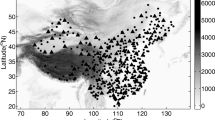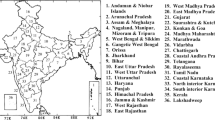Abstract
Air density plays an important role in assessing wind resource. Air density significantly fluctuates both spatially and temporally. But literature typically used standard air density or local annual average air density to assess wind resource. The present study investigates the estimation errors of the potential and fluctuation of wind resource caused by neglecting the spatial-temporal variation features of air density in China. The air density at 100 m height is accurately calculated by using air temperature, pressure, and humidity. The spatial-temporal variation features of air density are firstly analyzed. Then the wind power generation is modeled based on a 1.5 MW wind turbine model by using the actual air density, standard air density ρst, and local annual average air density ρsite, respectively. Using ρst overestimates the annual wind energy production (AEP) in 93.6% of the study area. Humidity significantly affects AEP in central and southern China areas. In more than 75% of the study area, the winter to summer differences in AEP are underestimated, but the intra-day peak-valley differences and fluctuation rate of wind power are overestimated. Using ρsite significantly reduces the estimation error in AEP. But AEP is still overestimated (0–8.6%) in summer and underestimated (0–11.2%) in winter. Except for southwest China, it is hard to reduce the estimation errors of winter to summer differences in AEP by using ρsite. Using ρsite distinctly reduces the estimation errors of intra-day peak-valley differences and fluctuation rate of wind power, but these estimation errors cannot be ignored as well. The impacts of air density on assessing wind resource are almost independent of the wind turbine types.
Similar content being viewed by others
References
Mallapaty S. How China could be carbon neutral by mid-century. Nature, 2020, 586: 482–483
National Energy Administration. The cumulative installed capacity of wind power has broken through 300 GW. http://www.nea.gov.cn/2021-11/30/c_1310343188.htm, 2022-03-21
Jin Y, Scherer L, Sutanudjaja E H, et al. Climate change and CCS increase the water vulnerability of China’s thermoelectric power fleet. Energy, 2022, 245: 123339
Archer C L, Jacobson M Z. Spatial and temporal distributions of U.S. winds and wind power at 80 m derived from measurements. J Geophys Res, 2003, 108: 4289
Zheng C, Xiao Z, Peng Y, et al. Rezoning global offshore wind energy resources. Renew Energy, 2018, 129: 1–11
Li J, Wang X, Yu X B. Use of spatio-temporal calibrated wind shear model to improve accuracy of wind resource assessment. Appl Energy, 2018, 213: 469–485
Ahmed A S. Wind resource assessment and economics of electric generation at four locations in Sinai Peninsula, Egypt. J Cleaner Product, 2018, 183: 1170–1183
Liu J, Gao C Y, Ren J, et al. Wind resource potential assessment using a long term tower measurement approach: A case study of Beijing in China. J Cleaner Product, 2018, 174: 917–926
Mahmoodi K, Saybani M, Azad S T. A temporal and spatial resolution wind and wave power resource assessment in the Oman Gulf. Ocean Eng, 2022, 249: 110881
Lima D C A, Soares P M M, Cardoso R M, et al. The present and future offshore wind resource in the Southwestern African region. Clim Dyn, 2021, 56: 1371–1388
Karthikeya B R, Negi P S, Srikanth N. Wind resource assessment for urban renewable energy application in Singapore. Renew Energy 2016, 87: 403–414
Tang X Y, Zhao S, Fan B, et al. Micro-scale wind resource assessment in complex terrain based on CFD coupled Measurement from multiple masts. Appl Energy, 2019, 238: 806–815
Mentis D, Hermann S, Howells M, et al. Assessing the technical wind energy potential in Africa a GIS-based approach. Renew Energy, 2015, 83: 110–125
Nie B, Li J. Technical potential assessment of offshore wind energy over shallow continent shelf along China coast. Renew Energy, 2018, 128: 391–399
Olaofe Z O. Review of energy systems deployment and development of offshore wind energy resource map at the coastal regions of Africa. Energy, 2018, 161: 1096–1114
Jung C, Schindler D, Laible J. National and global wind resource assessment under six wind turbine installation scenarios. Energy Convers Manage, 2018, 156: 403–415
Ren G, Wan J, Liu J, et al. Characterization of wind resource in China from a new perspective. Energy, 2019, 167: 994–1010
Saeed M A, Ahmed Z, Hussain S, et al. Wind resource assessment and economic analysis for wind energy development in Pakistan. Sustain Energy Tech, 2021, 44: 101068
Boudia S M, Santos J A. Assessment of large-scale wind resource features in Algeria. Energy, 2019, 189: 116299
Arenas-López J P, Badaoui M. Analysis of the offshore wind resource and its economic assessment in two zones of Mexico. Sustain Energy Techn, 2022, 52: 101997
Jung C, Schindler D. On the influence of wind speed model resolution on the global technical wind energy potential. Renew Sustain Energy Rev, 2022, 156: 112001
Saeed M A, Ahmed Z, Zhang W. Optimal approach for wind resource assessment using Kolmogorov-Smirnov statistic: A case study for large-scale wind farm in Pakistan. Renew Energy, 2021, 168: 1229–1248
Lu X, McElroy M B, Kiviluoma J. Global potential for wind-generated electricity. Proc Natl Acad Sci USA, 2009, 106: 10933–10938
Zhao J, Guo Z, Guo Y, et al. Wind resource assessment based on numerical simulations and an optimized ensemble system. Energy Convers Manage, 2019, 201: 112164
Farkas Z. Considering air density in wind power production. arXiv: 1103.2198
Ulazia A, Nafarrate A, Ibarra-Berastegi G, et al. The consequences of air density variations over northeastern Scotland for offshore wind energy potential. Energies, 2019, 12: 2635
Ulazia A, Ibarra-Berastegi G, Sáenz J, et al. Seasonal correction of offshore wind energy potential due to air density: Case of the Iberian Peninsula. Sustainability, 2019, 11: 3648
Ulazia A, Sáenz J, Ibarra-Berastegi G, et al. Global estimations of wind energy potential considering seasonal air density changes. Energy, 2019, 187: 115938
Akinsanola A A, Ogunjobi K O, Abolude A T, et al. Projected changes in wind speed and wind energy potential over West Africa in CMIP6 models. Environ Res Lett, 2021, 16: 044033
Collins J, Parkes J, Tindal A. Short term forecasting for utility-scale wind farms—The power model challenge. Wind Eng, 2009, 33: 247–257
Villena-Ruiz R, Ramirez F J, Honrubia-Escribano A, et al. A technoeconomic analysis of a real wind farm repowering experience: The Malpica case. Energy Convers Manage, 2018, 172: 182–199
Jung C, Schindler D. The role of air density in wind energy assessment —A case study from Germany. Energy, 2019, 171: 385–392
Liang Y, Ji X, Wu C, et al. Estimation of the influences of air density on wind energy assessment: A case study from China. Energy Convers Manage, 2020, 224: 113371
Liang Y, Wu C, Ji X, et al. Estimation of the influences of spatiotemporal variations in air density on wind energy assessment in China based on deep neural network. Energy, 2022, 239: 122210
Floors R, Nielsen M. Estimating air density using observations and re-analysis outputs for wind energy purposes. Energies, 2019, 12: 2038
Olauson J. ERA5: The new champion of wind power modelling? Renew Energ, 2018, 126: 322–331
Soares P M M, Lima D C A, Nogueira M. Global offshore wind energy resources using the new ERA-5 reanalysis. Environ Res Lett, 2020, 15: 1040a2
Gil Ruiz S A, Barriga J E C, Martínez J A. Wind power assessment in the Caribbean region of Colombia, using ten-minute wind observations and ERA5 data. Renew Energy, 2021, 172: 158–176
Hayes L, Stocks M, Blakers A. Accurate long-term power generation model for offshore wind farms in Europe using ERA5 reanalysis. Energy, 2021, 229: 120603
Soukissian T H, Karathanasi F E, Zaragkas D K. Exploiting offshore wind and solar resources in the Mediterranean using ERA5 reanalysis data. Energy Convers Manage, 2021, 237: 114092
Liu H, Dong L, Yan R, et al. Evaluation of near-surface wind speed climatology and long-term trend over China’s mainland region based on ERA5 reanalysis (in Chinese). Climat Environ Res, 2021, 26: 299–311
Zhang W, Zhang H, Liang H, et al. On the suitability of ERA5 in hourly GPS precipitable water vapor retrieval over China. J Geod, 2019, 93: 1897–1909
Picard A, Davis R S, Gläser M, et al. Revised formula for the density of moist air (CIPM-2007). Metrologia, 2008, 45: 149–155
Stull R B. Meteorology for Scientists and Engineers. 3rd ed. Vancouver: University of British Columbia, 2011
Wexler, A. Vapor pressure formulation for water in range 0 to 100°C. A revision. J Res Natl Bur Stand, 1976, 80A: 775–785
Wexler A. Vapor pressure formulation for ice. J Res Natl Bur Stand, 1977, 81A: 5–20
Daidzic N E. On atmospheric lapse rates. Int J Aviat Aeronaut, 2019, 6: 2
Svenningsen L. Proposal of an improved power curve correction. In: Proceedings of the Poster Presented at European Wind Energy Conference. Warsaw, 2010
Ren G, Wan J, Liu J, et al. Assessing temporal variability of wind resources in China and the spatial correlation of wind power in the selected regions. J Renew Sustain Energy, 2020, 12: 013302
Yuan W, Dai P, Xu M, et al. Estimating the impact of global warming on aircraft takeoff performance in China. Atmosphere, 2021, 12: 1472
Zhou T, Ren L, Liu H, et al. Impact of 1.5°C and 2.0°C global warming on aircraft takeoff performance in China. Sci Bull, 2018, 63: 700–707
Held I M, Soden B J. Robust responses of the hydrological cycle to global warming. J Clim, 2006, 19: 5686–5699
Karnauskas K B, Lundquist J K, Zhang L. Southward shift of the global wind energy resource under high carbon dioxide emissions. Nat Geosci, 2018, 11: 38–43
Ohba M. The impact of global warming on wind energy resources and ramp events in Japan. Atmosphere, 2019, 10: 265
Author information
Authors and Affiliations
Corresponding author
Additional information
This work was supported by the National Natural Science Foundation of China (Grant No. 52107091), the Fundamental Research Funds for the Central Universities (Grant No. 2022MS017), and the Science and Technology Project of CHINA HUANENG (Offshore wind power and smart energy system, Grant No. HNKJ20-H88).
Supporting Information
The supporting information is available online at https://tech.scichina.com and https://link.springer.com. The supporting materials are published as submitted, without typesetting or editing. The responsibility for scientific accuracy and content remains entirely with the authors.
Electronic supplementary material
11431_2022_2248_MOESM1_ESM.pdf
Investigating the impacts of spatial-temporal variation features of air density on assessing wind power generation and its fluctuation in China
Rights and permissions
About this article
Cite this article
Ren, G., Wang, W., Wan, J. et al. Investigating the impacts of spatial-temporal variation features of air density on assessing wind power generation and its fluctuation in China. Sci. China Technol. Sci. 66, 1797–1814 (2023). https://doi.org/10.1007/s11431-022-2248-4
Received:
Accepted:
Published:
Issue Date:
DOI: https://doi.org/10.1007/s11431-022-2248-4




